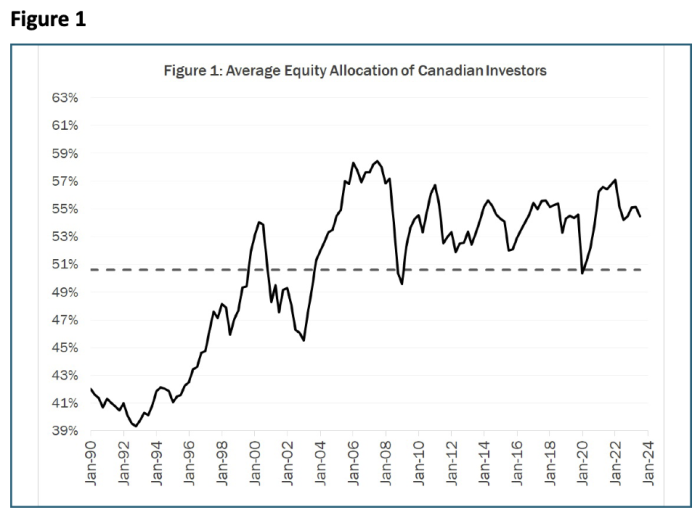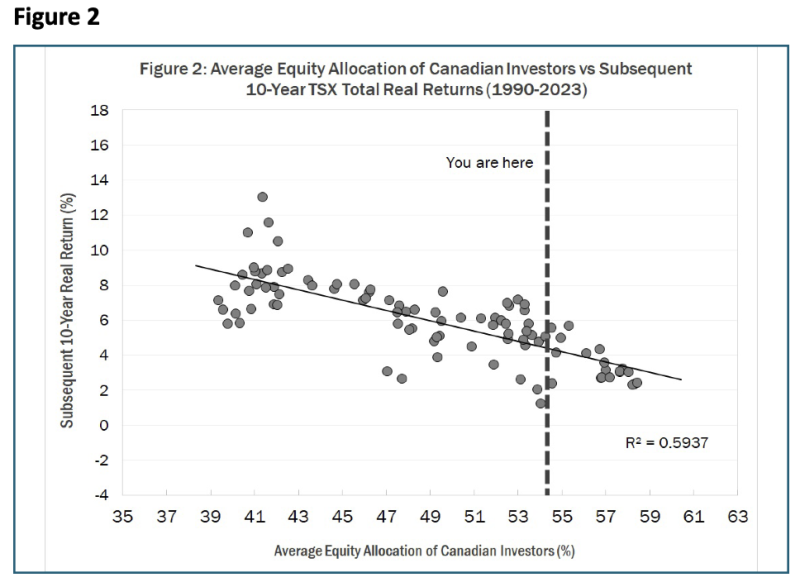The Single Greatest Predictor Of Canadian Stock Market Returns – Part 1
In 2013, financial blogger and analyst Jesse Livermore (pseudonym) published a widely distributed piece titled "The Single Greatest Predictor of Future Stock Market Returns"1. In it, he introduced a novel way of calculating the stock market allocation of the average U.S. investor and showed how changes to this metric explained approximately 91% of the change in subsequent 10-year stock market returns. Not only did he show the metric's remarkable predictive power to forecast equity returns, but he also showed that, as a stock market prediction tool, equity allocation was superior to every other commonly used valuation metric including P/E, Market Cap-to-GDP, Tobin Q, and the popular Shiller P/E (CAPE). In this article, we're going to use Livermore's calculation method to compute the average Canadian investor equity allocation back to 1990 and see if the strong correlation with future 10-year returns holds true for the Canadian market as well. In other words, we're going to see if the average investor equity allocation is, in fact, the single greatest predictor of stock market returns for the Canadian equity market.
Readers interested in all the gory details of the original calculation are invited to read Livermore's post referenced in the footnotes. For those looking for a more abridged version, a slight summary is in order. According to Livermore's methodology, we can assume that investors, as a group, allocate their portfolios between only three different types of asset classes: cash, bonds, and equities. The sum of the market value of all three asset classes constitutes the aggregate investor portfolio value, and by dividing the market value of stocks by the market value of this total portfolio, we end up with the total equity allocation held by the average investor. In the same way that a higher P/E ratio signals that investors are paying more for a dollar of earnings than they have in the past, so too does a higher equity allocation mean that investors have allocated a greater share of their portfolio to stocks than they have historically. The assumption, of course, is that higher investor equity allocations should naturally imply lower future returns since this means that stocks have effectively been bid up in price relative to cash and bonds. This is precisely what Livermore demonstrated in his piece, showing a predictive strength - or R² - of 0.91 (R² is a measure of a variable's predictive power, with 0 being the worst, and 1 being the best). Importantly, by knowing the current equity allocation of the average investor, Livermore demonstrated that we could forecast, with stunning accuracy, equity returns over subsequent 10-year periods.
The secret sauce to Livermore's methodology, however, was in his calculation of two critical inputs: the market value of cash and bonds. The problem with simply adding up the total value of all cash and bonds in existence is that a significant amount of cash and bonds is held by non-investors. In particular, banks and central banks (especially via Quantitative Easing (QE)) are large buyers of bonds, and hold them for reasons unrelated to their desired asset allocations as investors.
Livermore's calculation, on the other hand, is based on the equity allocation of investors, which should exclude the portion of cash and bonds held by banks (including central banks). His unique insight was that the total value of cash and bonds held by investors is, in fact, equal to the total value of the debt held by non-financial borrowers. This is because whenever borrowers take on debt, they create either cash or bonds that need to be held by someone in the economy. Consider a borrower who takes a loan from a bank. In a modern banking system, the bank will simply create a new deposit in the borrower’s bank account, resulting in new cash being created, which now forms part of the average investor's portfolio. By the same token, if a corporation takes out a loan, it results in a new bond being created which must now be held by either an investor, a bank, or a central bank. Critically, when a bank or central bank acquires a bond (via QE, for example), they would do so by creating new cash for the seller in exchange for the bond. In this sense, the bond is simply exchanged for cash, and the total value of cash and bonds held by investors remains unchanged.
With the above preamble out of the way, let's now turn our attention to calculating the average investor equity allocation for Canada to see just how predictive it is of subsequent 10-year returns of the TSX. To calculate the average investor equity allocation, we're going to follow Livermore's methodology as closely as possible using the national accounts data reported by Statistics Canada on a quarterly basis. Unfortunately, while the U.S. data in the original post was calculated all the way back to 1952, the Statistics Canada data goes back only as far as 1990. This is a relatively short period, which is going to limit our confidence in the findings to a certain degree. However, since there's no real way around this data problem, we will make do with what we've got. The average Canadian investor equity allocation from 1990 to the third quarter of 2023 is displayed in Figure 1. The dashed line is the average over the entire period of time.
Figure 1 shows that as of Q3 2023, the average equity allocation of Canadian investors stood at approximately 54.5% in stocks and 45.5% in cash/bonds. While a 54.5% stock allocation is certainly high relative to the early 1990s, compared to the generally higher equity allocations that have persisted since the dot-com crash, today's average equity allocation seems far more reasonable, albeit still slightly elevated. While it may be tempting to look at the chart and claim that equity allocations are currently in bubble-like territory and destined to fall back to their early-90s values, there's certainly an argument to be made that the investing landscape has changed markedly over the last 20 years, both in terms of the increasingly favourable sentiment toward holding stocks as well as the long secular trend of falling interest rates (leading to higher demand for alternative investments such as stocks).

Now, readers who are bearish on future Canadian stock market prospects are going to scoff at the “this time is different” suggestion. They’re going to latch onto the historically high equity allocation relative to the 90s and predict that investors are only temporarily and unreasonably highly allocated to stocks. During some future inevitable market crash, they’ll argue, investors will naturally rush for the gates to sell off their stock market holdings for the safety of bonds and cash, driving back down investor equity allocations to historical levels and restoring some preordained balance that supposedly exists in the equity universe. At some point, however, we need to acknowledge that if higher investor equity allocations have persisted for over 20 years now, perhaps investors have simply changed their preferences among asset classes in a structural way. Perhaps it isn’t a massive mispricing in the equity universe, and actually reflects a new norm among investors in their search for returns in a changing economic landscape. After all, how long must a deviation from the trend need to persist before it simply becomes a new trend? If two decades isn’t enough, what is? Three decades? Four? The doomsayers, it's clear, are never going to be happy.
Of course, none of this really matters unless the average investor equity allocation is, in fact, a strong predictor of future Canadian equity returns. Figure 2 shows the scatterplot comparing average investor equity allocations to subsequent 10-year total returns of the TSX. Note that, unlike the Livermore piece, we chart 10-year total real returns instead of nominal returns. While using nominal returns gives us a slightly better fit, it's ultimately real returns investors should care about.
The scatterplot in Figure 2 shows a clear relationship between the current equity allocation of Canadian investors and future 10-year stock market returns. In other words, the higher the current equity allocation, the lower the future return. With an R² of 0.59, the predictive power is relatively good, although we can't help but feel a bit underwhelmed. The relationship in the original Livermore piece, after all, showed that 91% of the variability in future U.S. equity returns was explained simply by changing the starting equity allocation. While the predictive relationship of 59% for Canada is certainly nothing to sneeze at, it's a far cry from being the "final word" on equity market forecasting with respect to the TSX.

At the current equity allocation of 54.5%, the model suggests a future 10-year total real return for stocks of 4.36% per year (see the dashed vertical line in Figure 2). The forecast, however, comes with considerable uncertainty given that the dispersion of dots around the trendline is reasonably large. We can see from Figure 2 that the historical range of returns for equity allocations in the 53%-56% range extends to approximately one per cent per year on the low end, and 7 per cent on the high end. A six per cent spread in the range of potential real returns is certainly nothing any investor is going to want to hang their hats on.
Now, it's important that we reiterate that with the data only extending back to 1990, and with each forecast being for the next 10-year period, we effectively only have data points spanning 1990 through 2013—just 23 years. It's possible that with a larger data series, we would get much better (or much worse) results; we just don't know. And unfortunately, unless Statistics Canada decides to expand their data series, we probably never will.
Data limitations aside, then, what's the verdict? Is the average investor equity allocation, with an R² of 0.59, as good a predictor of Canadian stock market returns as it gets? The answer, it turns out, is no. While an R² of 0.59 is certainly respectable, we've done extensive research on various valuation metrics over different time horizons with longer data sets and can say unequivocally that we can do better. Because we’ve been able to build out a data set that allows us to compare different valuation models as far back as the 1960s, we’re considerably more confident in the reliability of an alternative valuation model for Canadian stocks which is superior to investor equity allocation both from 1990 onwards and over the entire data set beginning in 1966. In part 2 of this series, we'll detail the different valuation metrics we've analyzed, expand on the methodology, and introduce what we believe to be the single best predictor of future Canadian stock market returns.
Brian Chang is the author of the finance blog Crusoe Economics (https://crusoeeconomics.com).
He resides in Vancouver and can be contacted by email at info@crusoeeconomics.com or on X @CrusoeEconomics.
https://www.philosophicaleconomics.com/2013/12/the-single-greatest-predictor-of-future-stock-market-returns/

